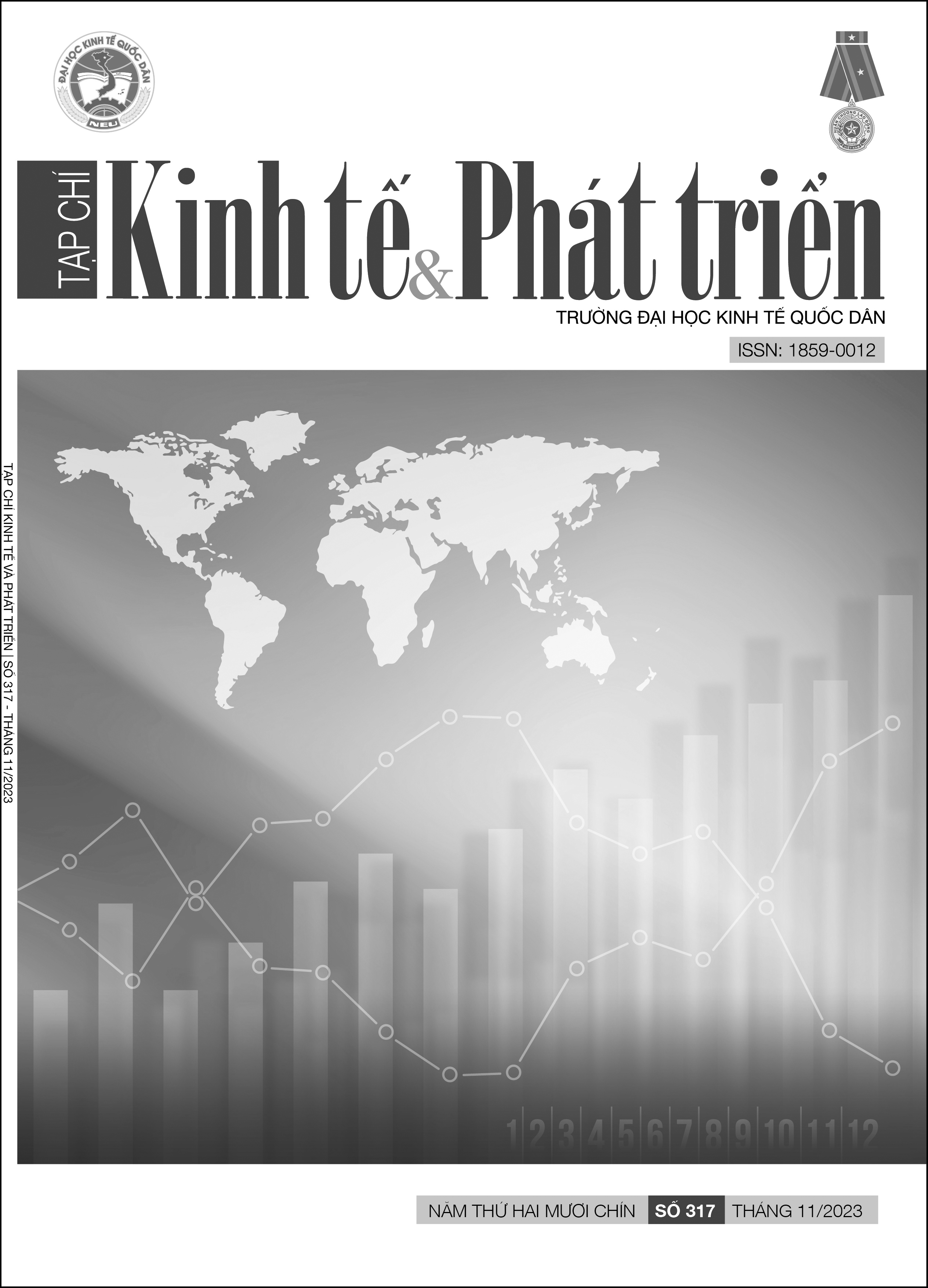Các yếu tố quyết định đến năng suất nhân tố tổng hợp của ngành chế biến thủy sản Việt Nam
DOI:
https://doi.org/10.33301/JED.VI.1202Từ khóa:
Kiểm soát hàm, hồi quy FGLS, năng suất nhân tố tổng hợp, chế biến thủy sản Việt NamTóm tắt
Bài viết nhằm phân tích các yếu tố quyết định đến năng suất nhân tố tổng hợp (TFP) của ngành chế biến thủy sản Việt Nam giai đoạn 2015-2020. Đầu tiên, chúng tôi sử dụng phương pháp kiểm soát hàm của Wooldridge (2009) để ước lượng hàm sản xuất và dự báo TFP. Sau đó, chúng tôi phân tích các yếu tố quyết định đến TFP theo năm khía cạnh: Đặc điểm nội bộ của doanh nghiệp; Hoạt động thương mại quốc tế; Hạn chế tài chính; Cường độ cạnh tranh; và Môi trường sản xuất, kinh doanh. Kết quả cho thấy Tuổi và quy mô doanh nghiệp có quan hệ thuận chiều với cả mức TFP và tăng trưởng TFP. Tỷ lệ lợi nhuận trên vốn chủ sở hữu có mối quan hệ ngược chiều với TFP, nhưng thuận chiều với tăng trưởng TFP. Yếu tố xuất nhập khẩu có mối quan hệ tích cực với năng suất, nhưng dư nợ tín dụng thì ngược lại. Cường độ cạnh tranh tác động tích cực đến mức TFP, nhưng tác động tiêu cực đến tăng trưởng TFP. Cuối cùng, các yếu tố về môi trường sản xuất, kinh doanh có mối quan hệ thuận chiều với năng suất.
Tài liệu tham khảo
Aghion, P., Angeletos, G.M., Banerjee, A. & Manova, K. (2010), ‘Volatility and growth: credit constraints and the composition of investment’, Journal of Monetary Economics, 57(3), 246-265.
Aghion, P., Harris, C., Howitt, P. & Vickers, J. (2001), ‘Competition, imitation and growth with stepby-step innovation’, Review of Economic Studies, 68(3), 467-492.
Bloom, N., Mahajan, A., McKenzie, D. & Roberts, J. (2010), ‘Why do firms in developing countries have low productivity?’, American Economic Review, 100(2), 619-623.
Camino, M.S. & Bermudez, B.N. (2021), ‘Productivity determinants in the construction sector in emerging country: new evidence from Ecuadorian firms’, Review of Development Economics, 25(4), 2391-2413.
Caselli, M. (2018), ‘Do all imports matter for productivity? Intermediate inputs vs capital goods’, Economia Politica, 35(2), 285-311.
Chu, S.N. & Kalirajan, K. (2011), ‘Impact of trade liberalization on technical efficiency of Vietnamese manufacturing firms’, Science, Technology and Society, 16(3), 265-284.
Coricelli, F., Driffield, N., Pal, S. & Roland, I. (2012), ‘When does leverage hurt productivity growth? A firm-level analysis’, Journal of International Money and Finance, 31(6), 1674-1694.
Fredriksson, P.G. & Svensson, J. (2003), ‘Political instability, corruption and policy formation: the case of environmental policy’, Journal of public economics, 87(7-8), 1383-1405.
Goncalves, D. & Martins, A. (2016), ‘The determinants of TFP growth in the Portuguese manufacturing sector’, GEE Papers, p.62.
Harris, R. & Moffat, J. (2015), ‘Plant-level determinants of total factor productivity in Great Britain, 1997-2008’, Journal of Productivity Analysis, 44(1), 1-20.
Jovanovic, B. & Nyarko, Y. (1996), ‘Learning by doing and the choice of technology’, Econometrica, 64(6), 1299-1310.
Lê Quang Cảnh (2017), ‘Chất lượng thể chế quản trị và tổng năng suất nhân tố của nền kinh tế Việt Nam’, Tạp chí Nghiên cứu kinh tế, 468(5), 12-19.
Levinsohn, J. & Petrin, A. (2003), ‘Estimating production functions using inputs to control for unobservables’, Review of Economic Studies, 70(2), 317-341.
Lucas, R.E. (1988), ‘On the mechanics of economic development’, Journal of monetary economics, 22(1), 3-42.
Mata, J. & Machado, J.A. (1996), ‘Firm start-up size: a conditional quantile approach’, European Economic Review, 40(6), 1305-1323.
Melitz, M.J. (2003), ‘The impact of trade on intra-industry reallocations and aggregate industry productivity’, Econometrica, 71(6), 1695-1725.
Ngô Hoàng Thảo Trang (2017), ‘Phân tích tác động của môi trường kinh doanh lên năng suất của doanh nghiệp vừa và nhỏ thông qua vai trò trung gian xuất khẩu và đổi mới’, Tạp chí khoa học đại học mở thành phố hồ chí minh-kinh tế và quản trị kinh doanh, 12(2), 173-188.
Nickell, S.J. (1996), ‘Competition and corporate performance’, Journal of Political Economy, 104(4), 724-746.
Okunade, S.O. (2022), ‘Institutional threshold in the nexus between financial openness and TFP in Africa: A dynamic panel analysis’, Social Sciences & Humanities Open, 5(1), p.100245.
Olley, G.S. & Pakes, A. (1996), ‘The dynamics of productivity in the telecommunications equipment industry’, Econometrica, 64, 1263-1297.
Rovigatti, G. & Mollisi, V. (2018), ‘Theory and practice of total-factor productivity estimation: the control function approach using stata’, The Stata Journal: Promoting Communications on Statistics and Stata, 18(3), 618-662.
Schumpeter, J.A. (1943), Capitalism, Socialism, and Democracy: Joseph A. Schumpeter, Allen and Unwin.
Syverson, C. (2011), ‘What determines productivity?’, Journal of Economic Literature, 49(2), 326-365.
Van Biesebroeck, J. (2005), ‘Firm size matters: growth and productivity growth in african manufacturing’, Economic Development and Cultural Change, 53(3), 545-583.
Villalpando, M. (2014), ‘Bank credit and productivity: evidence from Mexican firms’, Revista Mexicana de Economía y Finanzas, 9(2), 195-211.
Vives, X. (2008), ‘Innovation and competitive pressure’, The Journal of Industrial Economics, 56(3), 419-469.
Wagner, J. (2007), ‘Exports and productivity: a survey of the evidence from firm-level data’, The World Economy, 30(1), 60-82.
Wagner, J. (2013), ‘Exports, imports and firm survival: first evidence for manufacturing enterprises in Germany’, Review of World Economics, 149(1), 113-130.
Wooldridge, J. (2009), ‘On estimating firm-level production functions using proxy variables to control for unobservables’, Economics Letters, 104, 1263-1298.
Yasar, M., Paul, C.J.M. & Ward, M.R. (2011), ‘Property rights institutions and firm performance: a cross-country analysis’, World Development, 39(4), 648-661.





